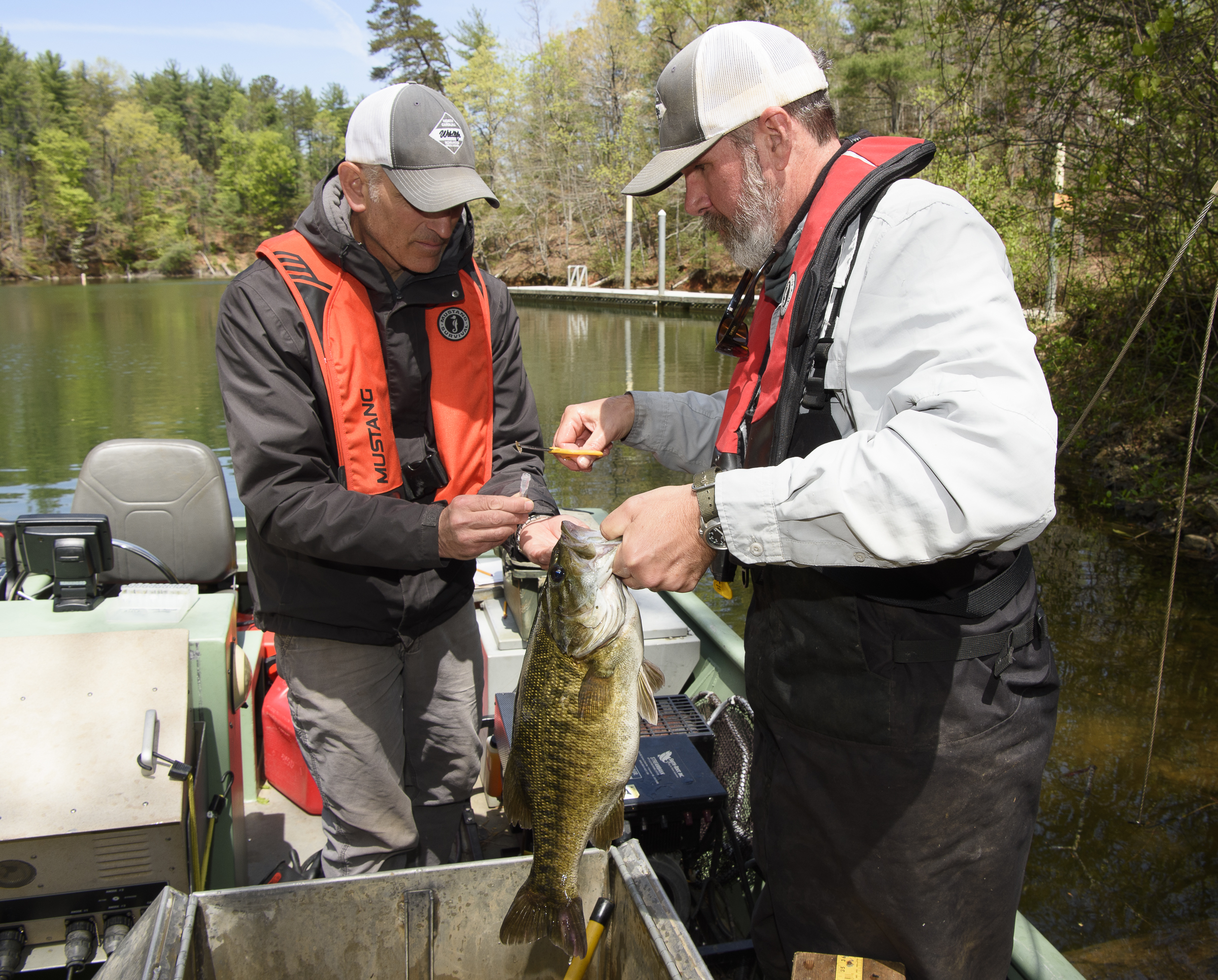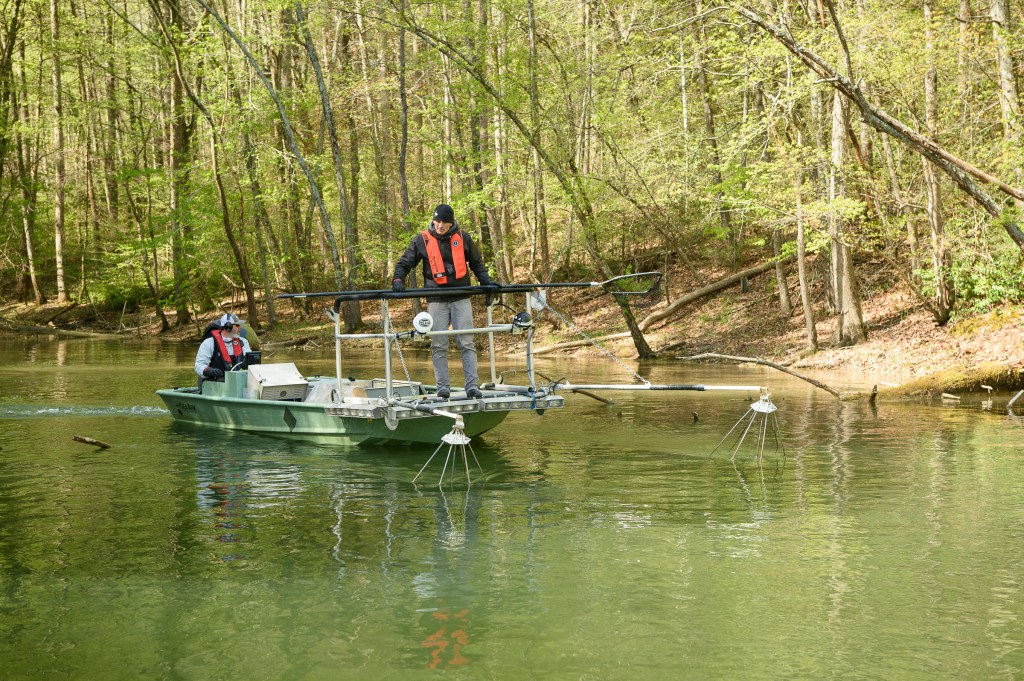
by North Carolina Wildlife Resources Commission staff
Invasive species come in all shapes and sizes and vary in types of animals and plants. They can be small, like the emerald ash borer (a beetle that has devastated ash trees across the country and in North Carolina) and zebra mussel (a fingernail-sized mollusk that can clog water filtration pipelines and alter water quality). Invasive species can be large, like flathead and blue catfish (which have outcompeted native catfish species in North Carolina waters) and tree of heaven (a fast-growing plant that can overwhelm and displace native species). Invasive species are introduced to an area outside of its original range, sometimes through natural migration but more commonly through human activities, like freight shipping, pet trade and accidental release. Once established, they can be difficult to control and have a dramatic impact on humans, wildlife and the environment. Approximately 42% of Threatened and Endangered species in the United States are at risk due to invasive species. In this article, we highlight one of the many invasive species that are a concern in North Carolina: Alabama bass. Although this article focuses on one species, many of the lessons learned and tips for limiting their spread can relate to many other invasive species, from avoiding releasing or relocating to learning how to identify species. To learn more about our native species and what can be done to help protect them, visit ncwildlife.org/learning.
A bass of mistaken identity
Alabama bass (Micropterus henshalli) have been moved outside their native range of the Mobile River Basin in central Alabama, northwestern Georgia, eastern-central Mississippi and the southeastern corner of Tennessee. Unauthorized angler introductions represent most Alabama bass translocations across the Southeast, including many confirmed introductions in North Carolina. Alabama bass were mistakenly identified as spotted bass (Micropterus punctulatus) for over 30 years due to their similarity of appearance. Around 2008, confirmation that these two bass are different species was accepted among university researchers and resource agencies when identification of these two species was verified with detailed anatomical counts and measurements and confirmed with genetic testing. To date, North Carolina Wildlife Resources Commission fisheries staff have genetically tested and confirmed Alabama bass are established in 30 waterbodies in the Tar Heel state, mostly in the Mountains and Piedmont. Sadly, this invasive, non-native bass is likely making its way eastward with recent reported occurrences in the Roanoke and Tar rivers.
History of Alabama bass in North Carolina
The first known occurrence of Alabama bass in North Carolina was in the early 1980s along the North Carolina-Georgia border in Lake Chatuge. In the two decades that followed, Alabama bass were illegally moved by anglers into many nearby impoundments in western North Carolina (e.g., Apalachia, Fontana, Glenville, Hiwassee, Julian, Nantahala, Santeetlah), with Lake Chatuge and the upper Savannah River Basin impoundments (Jocassee, Keowee, Hartwell) in South Carolina as the likely sources. By 2001, Alabama bass introductions were documented in Lake Norman. Alabama bass then were transported to other Catawba River lakes (e.g., James, Rhodhiss, Hickory, Lookout Shoals) upstream of Lake Norman in the early-to-mid 2000s, before being spread into central Piedmont impoundments in recent years.

Irreversible consequences
Smallmouth bass (Micropterus dolomieu) and spotted bass are native to drainages in western North Carolina that flow into the Mississippi River Basin. In every reservoir or river system where Alabama bass have been spread, native smallmouth bass and spotted bass populations have been dramatically impacted. Commission staff have learned through genetic testing that Alabama bass rapidly hybridize with smallmouth bass and spotted bass. The rate of hybridization is alarming. Within 10 to 15 years after Alabama bass become established, hybridization occurrence with smallmouth bass and spotted bass is 50–60%; 20 to 30 years out from the initial introductions, hybridization rates increase to 80–90%. Over time, the proportion of Alabama bass genes swamp- out smallmouth bass and spotted bass genes, and the two native species are irreversibly replaced. Largemouth bass (Micropterus salmoides), also native to North Carolina, are impacted by Alabama bass differently. Although hybridization between Alabama bass and largemouth bass does occur, the rate of hybridization is low. The primary impact to largemouth bass is through resource competition. Largemouth bass are efficient at what they do, but Alabama bass have a wider range of habitat and feeding tolerances and operate more successfully in the margins that are limiting to largemouth bass (e.g., deeper water, open water, low productivity zones, etc.). Therefore, largemouth bass are impacted by direct competition for available resources, which ultimately lowers their abundance over time. The outcome is that largemouth bass will be replaced to varying degrees by smaller, less-desirable Alabama bass.
What can be done?
It is illegal to move or stock fish into public waters without a stocking permit from the Commission. If you observe or have knowledge of illegal Alabama bass stockings, report it by calling 800-662-7137. If you catch an Alabama bass in a waterbody where they have not been previously documented, take photographs and report it at PublicInquiry-FishWildlife@ncwildlife.org. It is not possible to eradicate Alabama bass where they become established, but reducing their numbers as much as possible will minimize their impacts on native species. There is no size or creel limit for Alabama bass, and anglers are encouraged to harvest unlimited numbers of them of any size. Publicity and angler education efforts are ongoing, so be on the lookout for the updated black bass webpage, news stories and informational signage to be posted at public fishing and boating access areas.




